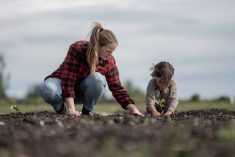It used to be mainly the East’s hort sector. Now, red tape over foreign workers is causing red ink for farmers in the very heart of the country, like Saskatchewan’s Mark Knox
Mark Knox is a beekeeper. He and his wife Janice have been keeping bees and harvesting honey for over 25 years now in Saskatchewan, where bees are serious business. The Knoxes are serious too. With 3,500 hives, the Knoxes are among the 10 largest operations in the province.
They run that business northeast of Nipawin, in the heart of canola-growing country and just on the edge of where agriculture gives way to the forest and lakes of the north. It’s beautiful country, and it’s a prime location for honey production. In all, some 36 commercial beekeepers in the area produce up to five million pounds of honey annually. At around $1.60 per pound that’s — well — a lot of honey.
Read Also

Building a farm legacy that outlasts you
A farm’s legacy isn’t just about the land; it’s also about the values and the impact that continue long after the current owner has stepped away.
Canada is the world’s sixth-largest honey producer, with yields at twice the global average due to our long summer days and nectar-producing crops like canola, alfalfa and sweet clover. Saskatchewan farmers grow most of these crops and the province’s beekeepers produce 25 per cent of the national honey production. The Knox’s area alone accounts for 60 per cent of the provincial production.
All this is to say that Mark Knox knows his business. He’s a director with the provincial beekeepers association, so he knows everyone else’s business too. And one of the biggest surprises about beekeeping is the number of people the industry employs.
Knox needed 23 employees in 2011. He found 19. Only one was Canadian. Two Mexicans and sixteen Nicaraguans formed the core of his roster, brought in under different sections of the federal Temporary Foreign Workers program.
Knox knows of only three — that’s three — commercial beekeepers in the entire province who do not hire foreign workers. It’s not that the others don’t want to hire local, they just can’t find anyone.
Offshore labour has always been considered a challenge for Ontario and British Columbia’s fruit and vegetable farmers. And there’s no question they still have challenges.
According to federal statistics, Ontario brought in 18,000 foreign workers through government programs in 2010, with B.C. and Quebec at roughly 3,500 each. Saskatchewan had 130, with all three prairie provinces at less than 1,500 combined.
But this isn’t a contest to see who has the biggest numbers, Knox says. Labour shortages affect one farm at a time, and the damage goes deep wherever you’re located.
“The bottom line is, to run my business I need workers,” Knox tells me. “If I can’t get any, I’m out of business.”
In fact, Knox believes it can sometimes be an even greater challenge outside of the traditional areas. In Ontario, for instance, help is available through the foreign agricultural resource management services, FARMS, a non-profit authorized by Ottawa to help facilitate and co-ordinate the processing of requests for foreign workers.
While there is no indication they will not help a grain farmer out west, the FARMS board of directors is made up entirely of Eastern interests and sectors, not one grain farmer among them.
A bigger challenge
Honey is an industry that’s seen some pretty big challenges. Five years ago Knox lost 60 per cent of his hives and that much production to the still unexplained effects of the varroa mite which causes bee disease and death. With $400,000 in losses plus ongoing payments and labour costs, it was a huge hit.
Extreme wet weather in the area last year meant slow, late crops and a shortened bloom, affecting production.
While these events hit their operation hard, however, none of them has sent Knox packing his bee boxes. But a lack of workers might.
Debra Hawer, project manager at Canadian Agricultural Human Resource Council, says the two agriculture-related programs under the federal Temporary Foreign Worker program are meeting some of agriculture’s labour needs, but aren’t the total solution.
The shortage is hurting farmers across the country. The most recent federal projections for 2013 show 50,900 non-seasonal and 38,800 seasonal positions will need filling. The horticulture sector has the highest vacancy rate and highest projected need.
At the same time, it’s interesting to note the surveys also indicate a significant gap in the ag sector’s human resource capacity, citing only 25 per cent of employers have an HR plan, and up to a third aren’t doing anything in recruitment and retention.
Don’t tell Mark Knox that. He spends what he considers an exorbitant amount of time on his human resource needs. Too much time, he says, and while he is very happy with the foreign workers he has hired, and while he has built lasting friendships with many, he’s not happy about the uncertainty he faces every year as he tries to get them to his farm.
Knox hires under both the Seasonal Agriculture Workers Program or SAWP, and a new agricultural stream under Occupations Requiring a Lower Level of Formal Training. It’s a program called NOC C & D — (Note: I didn’t make that up, it’s the actual title) — which we’ll call NOC here for short.
Applications for foreign workers go through at least three federal government departments: Human Resource Skills Development Canada (HRSDC), Immigration and Labour, and Border Services Canada.
Under the SAWP, workers can be hired only from Mexico and Caribbean countries. Knox says it is the easier program to navigate because the foreign government is involved in the process. Once a Canadian farm is approved, the foreign government looks after finding the employees, conducting required checks, setting up transportation and ultimately guaranteeing the person who will be replaced in the event it doesn’t work out.
The NOC program has no restrictions on country of origin, but much of the legwork is done by the farmer doing the hiring. Through a series of circumstances, Knox has hired mostly through the NOC program, mostly out of Nicaragua.
In either case there are a series of steps to acquire workers. Knox starts the process in August for workers he expects to arrive the following spring and into summer as his harvest progresses.
The whole thing hinges on an initial application sent to Service Canada and includes a completed labour market opinion (LMO). Through the LMO a farmer basically must prove how badly he needs people, how hard he’s tried to get them through advertising etc., and how few are available. If Service Canada is satisfied you’ve done all you can to hire locally, they send a letter of approval.
According to Knox, step one took two to four weeks when processed in the Saskatoon, but since that HRSDC office was closed, applications are now run through Vancouver, with wait times of 12 to 14 weeks.
“My business plan is based on labour and whether I can get labour or not,” Knox says. “Someone is making the decision in Vancouver… I’m depending on someone who doesn’t know anything about my business. So my business is always up in the air. It’s really hard on the nerves.”
If the LMO is approved, the next step is to find employees and submit their names to Immigration and Labour for a work permit. That’s another four to eight weeks of waiting. Then, if they are approved, the worker’s last hurdle is with Border Services where they can still be sent back at whatever border crossing or airport they use to enter the country.
If applications fail at any of these steps, Knox has to start over.
Other regulation changes have affected Knox. In the past temporary foreign workers could be eligible to work here for 48 months, but as of spring 2011 that’s down to one year. “The people who we invest in training are the first who can’t come back,” Knox says.
As well, the amount he can charge for housing under NOC has dropped from $250 per month to only $30 per week. Under the SAWP, employers cannot charge for housing at all. Knox doesn’t know how the numbers are arrived at but points to his own experience in Saskatchewan where housing is at a premium in most communities. Without available housing he’s paying from $1,500 to $2,600 per month for motel rooms.
Employers pay flight costs as part of the program. “I’ve spent $35,000 on flight tickets and haven’t gone anywhere,” Knox laughs. While the work is seasonal, his workers put in as many as 22,00 hours in that period, amounting to around $300,000 in wages for Knox.
Some might argue that’s money lost to local workers. And Knox understands the federal government’s objective. “I understand Canadians come first, but at five per cent unemployment Saskatchewan can’t get much lower. Policies for the East have an effect on the West. It’s a federal government initiative so I understand they can’t do it regionally. I get it, but it’s frustrating.”
While no one from HRSDC would speak with me, a written response indicated that each year over 20,000 workers enter Canada under the SAWP, with 80 per cent of those returning year after year.
Debra Hawer at CAHRC says many farmers are aware of the program, but make a conscious management decision not to hire foreign workers citing factors like the high degree of administration required and the costs involved. Her organization is currently coming up with an online Human Resource toolkit which will include a section on accessing the temporary foreign worker programs, navigating the process and special considerations around them.
Meanwhile, Knox is trying to sort out how he can keep his business humming in 2012. “There is room for expansion,” Knox says. “But I can’t spend money on capital expenditures if I’m not guaranteed a labour force.” CG














